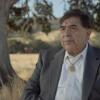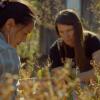Bii Gallardo: Building Relationships with Land to Fight For Climate Justice
Bii Gallardo was not deeply involved in environmental justice until a few years ago, but their connection to Earth was always there. Gallardo was taught at a young age to understand that people are a part of the land. “We’re no different from the stones we walk upon or the sky we walk under. We’re no different from the water we clean ourselves with and the water that we drink,” Gallardo said. “It’s all in relation to one another.”
Gallardo initially planned to pursue animal sciences in school, but their interests wandered and found a home in environmental studies and politics. Their days began filling up with events, ranging from protests in Los Angeles to classes at Pasadena City College — where they were oftentimes voiceless from chanting and screaming at a demonstration the day before. And any hour that was left over, they were working at a retail store and as a youth advisor for the Los Angeles County Department of Public Health.

“I’ve fallen in love with working with my community and working for social justice and environmental rights,” Gallardo said, who is from the Apache and Yaqui nations. “So I was kind of sad to not be fully engaged in my community and activism.”
But that has since changed. When Gallardo saw that there wasn’t a prominent Indigenous presence on campus, they started the Living Culture: Intertribal Student Collective, the first Indigenous club at Pasadena City College. As president, Gallardo wanted to create a safe space for both Indigenous and non-Indigenous students to learn and to build a community. The 19-year-old is also a core team member of the L.A. chapter of the International Indigenous Youth Council.
While finding their balance with school and work, Gallardo has been at the forefront of the climate change movement, regularly attending events and actively advocating for systematic change.
Gallardo is vocal about recognizing Indigenous representation when it comes to implementing laws, like the Green New Deal. “It’s important to work with Native people because this is their territory. We need to work with Native people to establish what’s best for that specific environment and what’s best for that specific territory,” Gallardo said. “All territories in the U.S. are very different and Native people have been working with them for thousands and thousands of years. They’re going to know the land better than anyone else.”
I’ve fallen in love with working with my community and working for social justice and environmental rights.Bii Gallardo
They also urge lawmakers to consult with different Nations to move forward with reparations. “It starts with acknowledging what really happened here in the California territories,” the activist said. “And when we talk about reparations, we’re talking about working directly with the stewards of the land. It’s really what they deem needs to happen to start building those reparations.”
In December 2019, young people throughout L.A., including Gallardo, attended the Youth Climate Strike L.A. protest, where as a part of their “first official step into activism,” Gallardo took to the front of city hall to speak to the crowd. Among various other topics, Gallardo spoke about the harm of glorifying young activists. They then marched with the other protesters to the Los Angeles Department of Water & Power to demand new environmental policies.

According to them, climate celebrities — or activists that have become prominent within the movement — can overshadow the work that’s been done by other communities and in past generations. By being the face of the campaign, climate celebrities can also be easily targeted by those who are against its ideals.
“It’s important to understand that in this climate community, everyone holds a role. It’s not someone working through everything. It’s not a corporation. It’s not someone who’s the head honcho, telling everybody what to do,” Gallardo said. “It’s everybody finding their role in this crisis, moving to build and work together.”
Along with the glorification of young activists, Indigenous people in the environmental justice movement have also been romanticized.
“In my experience, it’s kind of tiring, as an Indigenous youth. Going all over the place to do a single land acknowledgement, which is great, but it doesn’t stop at a land acknowledgement,” Gallardo said. “It’s about building relations. It’s about wanting to listen to youths. It’s one thing to have them there to be your representation check box, but it’s actually making space and bringing in other BIPOC.”
It’s important to work with Native people because this is their territory .... All territories in the U.S. are very different and Native people have been working with them for thousands and thousands of years. They’re going to know the land better than anyone else.Bii Gallardo
Gallardo believes that to change how the climate strike movement is viewed, it must begin with how it is covered by social media and the news. “Media can communicate better with communities of color and really shine light to grassroots groups who’ve been putting in the work,” they said.
“It’s tiresome at the very least,” the young activist said about feeling like not being fully heard. “But at the same time, I know it’s my role to be here and to help.”
While the brunt of working towards environmental justice can be exhausting for Gallardo, especially as a working college student, this is what they want to do. “I really want to send out, as a message, the importance of building a relationship with land,” they said. “It’s taught me balance. It’s taught me everything I know.”









